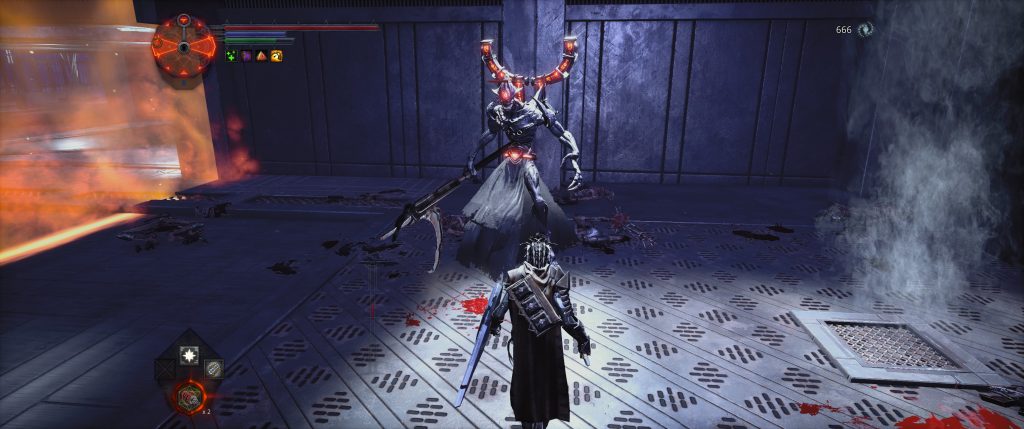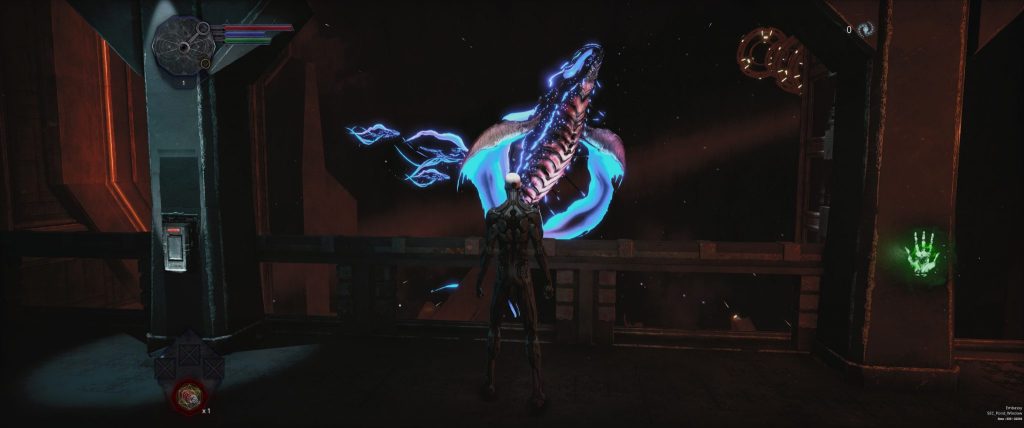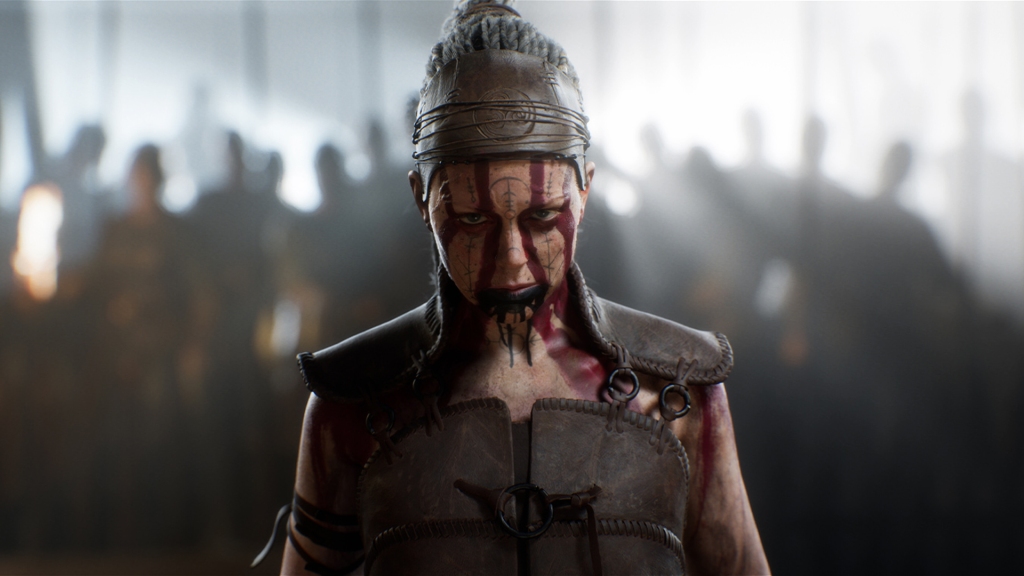
It’s weird to think that From Software have managed to create a whole new genre of action game, yet that’s exactly what they did with Demon’s Souls, Bloodborne and the Dark Souls trilogy. Hard as nails combat, exploration, baffling stories and a willingness to invest a lot of time are just so of the things that have come to define Souls-like titles. And there’s no shortage of games being released that have obviously been inspired by From Software. Today, I’m taking a look at one of them: Hellpoint, from Cradle Games.
On paper Hellpoint’s marriage of Dark Souls with science fiction is downright sexy, and on occasion, Hellpoint manages to make good on the idea with a cool vista. However, the majority of your time is actually spent traipsing through boring grey corridors and trying to remember where the hell anything is. Like Dark Souls world, the giant ship Hellpoint takes place on was not designed by someone trying to make something sensible. Rather, it was designed by someone who desperately wanted to work on mazes but couldn’t get the job and thus settled for making regular people’s days into a freaking nightmare. I’m not against complex map design that takes proper exploration and memorization, but you still need those little design cues to help guide players just a fraction, otherwise so much time is spent doing absolutely nothing of consequence. Hellpoint’s giant ship is so packed with generic corridors and rooms that it becomes increasingly difficult to remember specific locations and routes. If you do find something of important like a key card or a boss it feels more like you accidentally stumbled in and now the big bad boss is looking just as confused as you are.

Available On: PC, Xbox One, PS4
Reviewed On: PC
Developer: Cradle Games
Publisher: Tinybuild
Review code provided free of charge by the publisher
But while I think general exploration is muddled thanks to the lack of visually interesting areas, I do appreciate the game’s love of hiding secrets. Just about everywhere you look there’s stuff to find, and secret doors often lead to more secret doors.
Dark Souls is famous for not having much of a narrative upfront while also having a deep lore for people who are willing to spend the time putting it all together. When you combine that with the excellent visuals it creates a compelling world that is worth exploring. Hellpoint aims for the same thing, but while it nails the first part it forgets the rest. You wake up as a newly created Spawn on a giant space ship and set out with a sword and shield to kill the monsters, beasties and cosmic gods inhabiting the place. And that’s about it. You’ll find terminals and scrawled messages here and there and maybe even an NPC or two, but the information they give you is, at best, incredibly vague. Hellpoint’s storytelling is like being handed a join-the-dots page with three dots and a message telling you to use your imagination. It constantly raises and then gives you no answers to any of them, not even the vaguest of hints. If I wanted meaningless drivel I’d just read my own damn reviews, Hellpoint.
At least it does nail the atmosphere. While it is quite visually dull the generally dark ship and the lack of music gives Hellpoint an eery feeling. It’s a shame it doesn’t actually lean into the horror elements more, perhaps bringing in a touch of Dead Space. However, it’s not a very visually cohesive game. A lot of the enemy designs don’t fit together or seem like they have anything to do with each other or like they even belong in the world.
Hellpoint does manage to do a few things better than Dark Souls, though. Breaches scattered around act as save and respawn points, but unlike Dark Souls whenever you visit them to spend Axiom points on stat upgrades or to fast travel enemies won’t immediately respawn. Instead, enemies will only respawn after a while has passed or if you die. As for the fast traveling, you can occasionally find an item that lets you “synchronize” Breaches, letting you travel between them. These items are nicely balanced so that you always have to really consider whether it’s worth connecting a Breach or saving it for somewhere else.
If and when you do die, and you certainly will, all your hard-earned Axiom points get dropped and you have to and recover them. Hellpoint tosses an obstacle in your way in the form of a bright green ghost of yourself, boasting all the same equipment you were wearing upon your death. With that said, Casper the Sodding Annoying Ghost doesn’t seem to have the same stamina and energy limitations. I’ve got mixed feelings on this strange mechanic. It’s a neat idea, and I think it would have worked if the ghost replicated your own fighting style in order to force you to try new things, but in its current form, it’s just an irritating roadblock.

The other thing Hellpoint does quite well is its combat Again, the Dark Souls influence is obvious with light and heavy attacks mapped to the right shoulder bumper and trigger, and a shield on the left bumper. Blocking and dodging are your forms of defense, while a stamina meter dictates pretty much everything you can do in a fight. The controls feel quick and responsive, and the amount of time you get to dodge, block or get out of the way makes it difficult but never unfair. Overall, on the Souls-like scale I’d say Hellpoint is a much more forgiving game, but you still need patience to win the bigger fights. If you don’t pay attention and learn how an enemy fights you’re going to get stomped into the dirt.
I also like how Hellpoint encourages you to go on the offensive. By attacking you refill the charges on your healing item, so the only way to patch yourself up is to stop hiding and start striking. Likewise attacking powers up your energy meter which in turn lets you use a lot of the ranged attacks.
Unfortunately, I don’t think the combat evolves enough throughout the game. Each battle feels similar: dodge, slice, slice, dodge. Repeat. The flow of a fight at the start of the game is almost exactly the same as it is toward the end, with the only real differences being in the type of weapon you’re wielding. The same goes for the boss fights with none of them standing out as being memorable or mechanically interesting. They all play out like normal fights, except now you also have to deal with frustrating stun-lock moves.
There doesn’t seem to be any lore or explanations behind the bosses, either, so it’s like they’ve just been randomly dropped from the sky. Who is this big fat thing and why is it standing at a generic junction for no apparent reason? No idea. And Hellpoint has a horrible habit of having big bosses appear as smaller, regular enemies which is just wrong. What very little personality the bosses have is stripped away when you see they roaming the corridors in much smaller form. Are they all going out and having babies and then sending them out to patrol this vast space station?
Still, if you enjoy Dark Souls and other games like it primarily for the fighting you might find Hellpoint worth playing, even if it’s lagging behind the rest of the pack.
There’s a lot of different gear and weapons to find, equip or craft, too. And in a smart move weapons will unlock new perks and abilities as you use them, giving you a reason to find something you like and stick with it. This works nicely with being able to invest resources in boosting a weapon’s stats to give you a nice sense of ownership over your gear.
Mind you, there’s a lot of rough edges to deal with. Seeing enemies spinning on the spot or getting complete stuck is a very common problem. I’ve had important NPCs fall straight into pits, and at one point a character called The Architect suddenly vanished from the Observatory. Upon investigation, I found he had completely reset himself to his original starting point and now wanted to go through his annoying little quest again. I’ve also been frozen in spot, and got stuck in menus. The overall performance seems pretty wild, too, with big framerates occurring, although they never made it truly unplayable.

And then there are Hellpoint’s platforming moments. There’s a lot of secrets within the game which I actually admire, but some of them, as well as general progress, require a bit of jumping. Unfortunately leaping around is stiff and awkward, which makes trying to make even reasonably basic jumps feel like trying to control an extremely drunk Mario. It doesn’t help that fall damage bounces madly from “ah, you’ll be okay” to, “Holy shit! That was a big 5ft drop! Sorry, you’re deceased.”
The online co-op aspect should be a big selling point of Hellpoint. Players can leave handprints inviting other people to come help them out, and you can even specifically get friends to join using a code system. However, prior to launch, it was almost impossible to join other players, and the twice that I managed it the first time disconnected me after a minute or two and the second caused the framerate to tank. So I decided to wait until after launch, and to my dismay a day after launch the multiplayer was turned off entirely. I’ve given up waiting, and as I write this it has finally returned, but still doesn’t work very well.
The good news is the local split-screen co-op works great! You can play through the whole game with somebody by your side, which makes things considerably easier as the enemy A.I. struggles to deal with two players.
The other way to interact with people is by leaving messages, but you have to use a selection of awkward pictographs. It’ll be interesting to see if people agree on a code via the Steam forums or something.
Hellpoint is another one of those games that wears its Dark Souls inspirations proudly but doesn’t understand what exactly makes Dark Souls so beloved. It struggles to forge an identity for itself, while also not doing any of the main Souls mechanics as well as other games. It does, however, have a certain rough charm hiding within its bleak sci-fi corridors and behind its many, many hidden doors. If you’re a glutton for smacking evil stuff around and getting lost then Hellpoint might be worth buying after a price drop.





